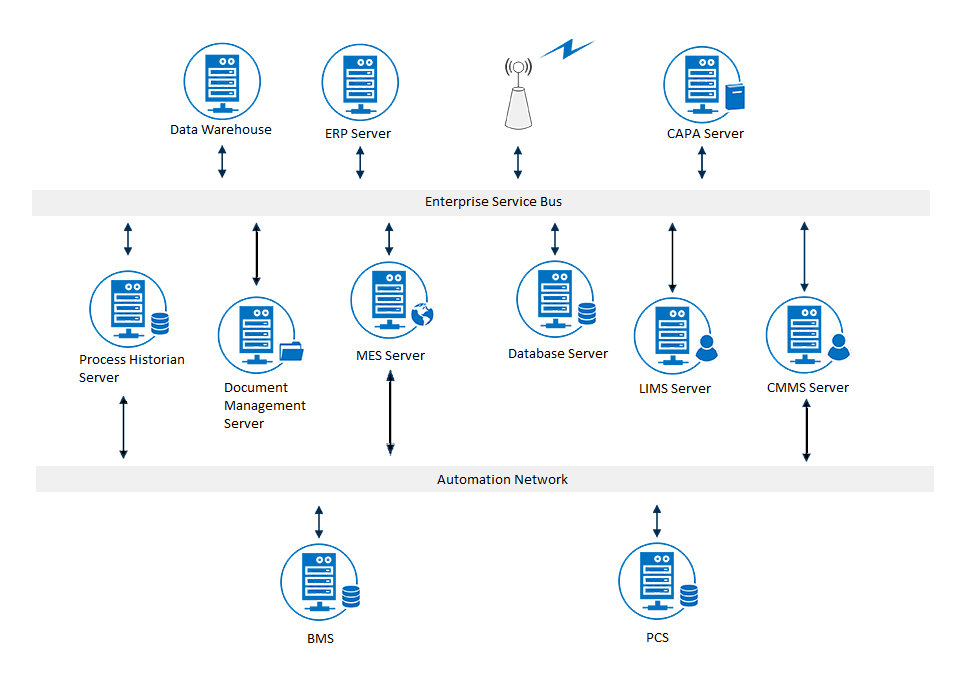System Integration
Keeping multiple enterprise systems in sync requires significant technical understanding along with the right business knowledge.Why MES – Centered System Integration?
Companies have numerous complex and critical IT systems. Synchronizing the data from all the systems between areas makes it visible throughout the business enterprise, avoiding duplication and maximizing IT investments. It also enables visibility of plant-floor data in or near real time, standardization of processes, increased operational excellence and lower operating costs.Manufacturing Execution Systems
The figure below illustrates how an MES-centered integration links various systems together : With an emphasis on MES systems, our professional consultants have extensive experience integrating these systems to share relevant information.
With an emphasis on MES systems, our professional consultants have extensive experience integrating these systems to share relevant information.
ERP: While MES directs operator activity on the production floor, it may not be the owner of the data. When an ERP system, such as SAP or JDE, is that owner, on-the-floor material consumptions must be reported in real time to ERP to keep the inventory levels accurate. These material lot consumptions establish product genealogy, providing complete history information to ERP. Batch start & stop times assist with finite scheduling.
LIMS: MES can use and record this data to help ensure the quality of materials and products that are consumed or produced by production-related activities. Stored in a single database, this data supports efforts to track genealogy for a specific batch or lot.
CAPA: MES systems are often the first to detect out of specification conditions. When these situations occur, interfacing to a Corrective and Preventive Action system provides a single place where all process deviations are logged and the appropriate corrective action is maintained.
DMS: When properly interfaced, MES systems are able to retrieve documents directly from a DMS and display them on-screen for the operator at the time and point of use. Keeping electronic copies at the production operator’s fingertips eliminates the need for hard-copies throughout the facility, and minimizes the chances of referencing out-of-date revisions.
Reports: When an MES system directs operator activity and records operator data entry, all information is stored in a centralized database. From this single storehouse of data, reporting software can be used to pull and display any type of data for any specific event/task. For example, genealogy for a given production batch can be determined in seconds, savings thousands of dollars, and hours/days/weeks of time. Available electronically from anywhere within a company’s secure network, these reports can help save time, money, lost product, and help ensure the quality of the output product.
Process Historian : Often the system of record, today’s process data historians store more that just time series data. Whether on premise or in the cloud, integration of process data with MES data provides information in context to allow users to take meaningful actions.
CMMS : Computerized Maintenance Management Systems often store maintenance schedules as well as history. Integrating this information with process data and automated workflows provides a powerful solution aimed at reducing the overall maintenance budget and unplanned downtime.
BMS : Today’s Building Management Systems often include pervasive sensing and smart instrumentation. Integrating this with automated workflow and process information allows for the development of logic and models to predict peak energy usage and minimize energy costs using closed loop control.
PCS : Process Control Systems have a wide variety of configurations that may be fully integrated or islands of automation. In either case, the PCS generates huge amounts of raw data. It is crucial to integrate this data with other systems to provide contextual information that can be specifically targeted for job functions throughout the facility and the enterprise.
Extensive experience in numerous MES-related projects has cultivated a deep skill set within our consultant team, in all phases of a given integration project. From assistance with problem identification, project scoping and user requirements to developing and implementing technical solutions, EIS professionals help ensure successful synchronization and optimal operation of the systems that are the business lifelines of our valued customers.

